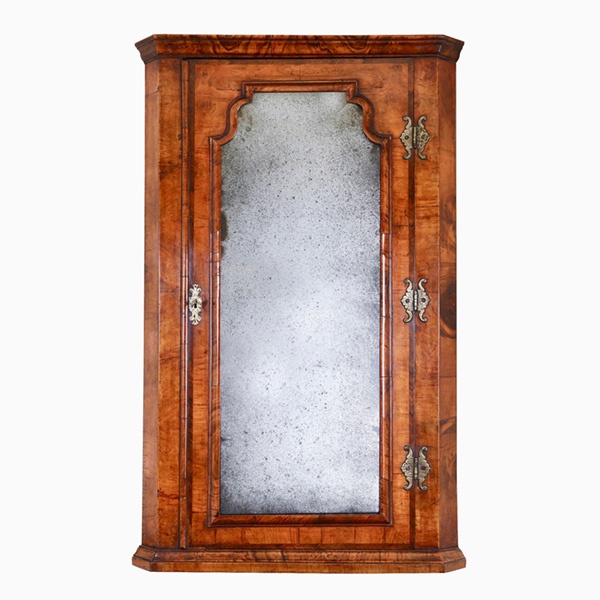18th Century German Equinoctial Pocket Sundial and Compass by Ludwig Theodor
SOLD
Request Information
Follow Us
18th Century German Equinoctial Pocket Sundial and Compass by Ludwig Theodor
From the first quarter of the 18th century – a German brass equinoctial pocket sundial by Ludwig Theodor Muller, Augsburg. The sundial consists of three parts: a richly engraved octagonally shaped gilt brass base, which holds a recessed compass with circular glass; a hinged silvered brass sector to adjust the latitude; and a hinged silvered hour ring with a sprung folding central gnomon to read the time. The sundial rests on three solid brass turned adjustable bun feet.
To position the instrument, use can be made of the compass, which has a silver centre with rose and radial lines engraved with Latin annotations (S for Septentriones (north), E for Emendor (magnetic declination), OR for Orientalis (east), M for Meridianus (south) and OC for Occidentalis, the four cardinal points. The underside of the compass is engraved with the following placenames and indications: Elev Poli, Lisbon 39; Rom 42; Venedig 45; Wien, Munch, Augsp. 4X; Nurnb, Regensp 49; Prag, Cracau 50; Leizig 51 over the monogram L.T.M, the initials of the maker. When the compass needle is directed to the north, the latitude can be adjusted on the sector on the basis of the observer’s position. The time can then be read by the shadow which the needle gnomon casts on the hinged open hour silvered circle pivoting against the folding curved latitude scale and engraved in reverse III-XII-IX with stylized wheatear half-hour markers.
The maker
Ludwig Theodor (or Ludovicus Theodatus) Müller was active a compass and sundial maker in Augsburg from circa 1710. He died in 1770.
Condition
Good. Wear consistent with age and use.
Dimensions
Height: 6 in. (15.24 cm)
Diameter: 6.5 in. (16.51 cm)
PREVIOUSLY SOLD
No Results Found
The page you requested could not be found. Try refining your search, or use the navigation above to locate the post.
No Results Found
The page you requested could not be found. Try refining your search, or use the navigation above to locate the post.
YOU MAY ALSO LIKE

17th Century Figured Walnut and Seaweed Marquetry Lace Box
17th Century Figured Walnut and Seaweed Marquetry Lace Box £3,600 Follow Us17th Century Figured Walnut and Seaweed Marquetry Lace Box A fine and extremely rare figured walnut and seaweed marquetry 'lace box', circa.... let’s break it down -...

19th Century Repeating Gilt-Brass Carriage Clock by the Famous Drocourt
19th Century Repeating Gilt-Brass Carriage Clock by the Famous Drocourt £5,600 Follow Us19th Century Repeating Gilt-Brass Carriage Clock by the Famous Drocourt A superb repeating carriage clock with a gilt-brass gorge case by the famous maker...

17th-Century Hague Clock Signed by Pieter Visbagh, circa 1675
Small 17th Century Hague clock made c. 1675 by Pieter Visbagh, who was apprenticed by Salomon Coster. The latter made the first pendulum clock according to the instructions of Christiaan Huygens, the internationally renowned scientist who developed the idea of applying a pendulum to a clock movement.

Pair of 18th-Century English Rococo Gilt Bronze Andirons or Firedogs
An exceptional pair of 18th century English Rococo gilt bronze andirons or fire dogs.
The bold shape of these andirons relate to designs of Thomas Johnson (1714–1778), one of London’s pioneers of the ‘Modern’ or French style, later known as Rococo.

Queen Anne Walnut Corner Cupboard with Bevelled Mirror Plate
A truly remarkable find in original condition. To the door a shaped soft bevelled mirror plate is framed by a cross-grain molding of typical queen Anne design which is further cross-banded, feather-banded and edged to the opening with a single de-molding.

17th Century Figured Walnut and Seaweed Marquetry Lace Box
17th Century Figured Walnut and Seaweed Marquetry Lace Box £3,600 Follow Us17th Century Figured Walnut and Seaweed Marquetry Lace Box A fine and extremely rare figured walnut and seaweed marquetry 'lace box', circa.... let’s break it down -...

19th Century Repeating Gilt-Brass Carriage Clock by the Famous Drocourt
19th Century Repeating Gilt-Brass Carriage Clock by the Famous Drocourt £5,600 Follow Us19th Century Repeating Gilt-Brass Carriage Clock by the Famous Drocourt A superb repeating carriage clock with a gilt-brass gorge case by the famous maker...

17th-Century Hague Clock Signed by Pieter Visbagh, circa 1675
Small 17th Century Hague clock made c. 1675 by Pieter Visbagh, who was apprenticed by Salomon Coster. The latter made the first pendulum clock according to the instructions of Christiaan Huygens, the internationally renowned scientist who developed the idea of applying a pendulum to a clock movement.

Pair of 18th-Century English Rococo Gilt Bronze Andirons or Firedogs
An exceptional pair of 18th century English Rococo gilt bronze andirons or fire dogs.
The bold shape of these andirons relate to designs of Thomas Johnson (1714–1778), one of London’s pioneers of the ‘Modern’ or French style, later known as Rococo.

Queen Anne Walnut Corner Cupboard with Bevelled Mirror Plate
A truly remarkable find in original condition. To the door a shaped soft bevelled mirror plate is framed by a cross-grain molding of typical queen Anne design which is further cross-banded, feather-banded and edged to the opening with a single de-molding.













